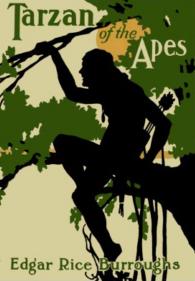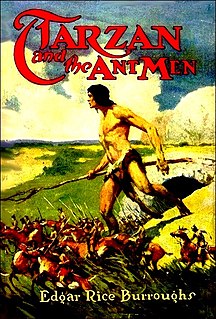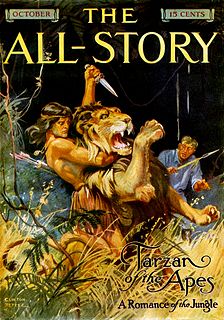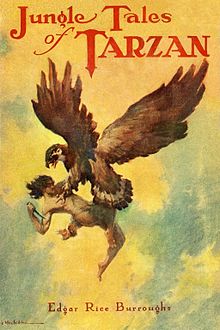
Edgar Rice Burroughs was an American author, best known for his prolific output in the adventure, science fiction, and fantasy genres. Most well-known for creating the characters Tarzan and John Carter, he is also known for writing the Pellucidar series, the Amtor series, and the Caspak trilogy.

Russell George Manning was an American comic book artist who created the series Magnus, Robot Fighter and illustrated such newspaper comic strips as Tarzan and Star Wars. He was inducted into the Will Eisner Award Hall of Fame in 2006.

Tarzan of the Apes is a 1912 story by American writer Edgar Rice Burroughs. It was first serialized in the pulp magazine The All-Story beginning October 1912 before being released as a novel in June 1914.
Mangani is the name of a fictional species of great apes in the Tarzan novels of Edgar Rice Burroughs, and of the invented language used by these apes. In the invented language, Mangani is the apes' word for their own kind, although the term is also applied to humans. The Mangani are represented as the apes who foster and raise Tarzan.

Tarzan the Untamed is a book by American writer Edgar Rice Burroughs, the seventh in his series of twenty-four books about the title character Tarzan. It was originally published as two separate stories serialized in different pulp magazines; "Tarzan the Untamed" in Redbook from March to August, 1919, and "Tarzan and the Valley of Luna" in All-Story Weekly from March to April 1920. The two stories were combined under the title of the first in the first book edition, published in 1920 by A. C. McClurg. In order of writing, the book follows Jungle Tales of Tarzan, a collection of short stories about the ape-man's youth. Chronologically, it follows Tarzan and the Jewels of Opar.

The Return of Tarzan is a novel by American writer Edgar Rice Burroughs, the second in his series of twenty-four books about the title character Tarzan. It was first published in the pulp magazine New Story Magazine in the issues for June through December 1913; the first book edition was published in 1915 by A. C. McClurg.

Tarzan and the Ant Men is a novel by American writer Edgar Rice Burroughs, the tenth in his series of twenty-four books about the jungle hero Tarzan. It was first published as a seven-part serial in the magazine Argosy All-Story Weekly for February 2, 9, 16 and 23 and March 1, 8 and 15, 1924. It was first published in book form in hardcover by A. C. McClurg in September 1924. The story was also adapted for Gold Key Comics in Tarzan #174-175 (1968).

Tantor is a generic name for elephants in Mangani, the fictional language of the great apes in the Tarzan novels of Edgar Rice Burroughs. In Burroughs's works a number of elephants appear under the name of Tantor, most notably one particular bull elephant the ape man befriends in his youth in the first Tarzan novel, Tarzan of the Apes and in the 1999 Animated walt disney flim he is red African Forest Elephant and friends with Terk.

The Son of Tarzan is a novel by American writer Edgar Rice Burroughs, the fourth in his series of twenty-four books about the title character Tarzan. It was written between January 21 and May 11, 1915, and first published in the magazine All-Story Weekly as a six-part serial from December 4, 1915 to January 8, 1916. It was first published in book form by A. C. McClurg & Co. in March 1917 and has been reprinted numerous times since by various publishers.

Tarzan and the Golden Lion is an adventure novel by American writer Edgar Rice Burroughs, the ninth in his series of twenty-four books about the title character Tarzan. It was first published as a seven part serial in Argosy All-Story Weekly beginning in December 1922; and then as a complete novel by A.C. McClurg & Co. on March 24, 1923.

Tarzan, Lord of the Jungle is a novel by American writer Edgar Rice Burroughs, generally considered the eleventh in his series of twenty-four books about the title character Tarzan. It was first published as a serial in Blue Book Magazine from December 1927 through May 1928; it first appeared in book form in a hardcover edition from A. C. McClurg in September 1928.

Tarzan and the City of Gold is a novel by American writer Edgar Rice Burroughs, the sixteenth in his series of twenty-four books about the title character Tarzan. The novel was originally serialized in the magazine Argosy from March through April 1932.

Tarzan and the Foreign Legion is a novel by American writer Edgar Rice Burroughs, the twenty-second in his series of twenty-four books about the title character Tarzan. The book, written June–September 1944 while Burroughs was living in Honolulu and published in 1947, was the last new work by Burroughs to be published during his life. The novel is set during World War II in Sumatra, Dutch East Indies. The term "foreign legion" does not refer to the French Foreign Legion, but is the name given in the book to a small international force fighting the Empire of Japan.

Tarzan and the Castaways is a collection of three stories by American writer Edgar Rice Burroughs, the 24th and final in his series of twenty-four books about the jungle hero Tarzan. The title novella, and the two short stories were first published in pulp magazines in 1940 and 1941. The combined book was published first as a hardcover by Canaveral Press in early 1965, and as a paperback by Ballantine Books in July 1965.

Tarzan and the Tarzan Twins is a collection of two Tarzan novellas by American writer Edgar Rice Burroughs, for younger readers. It was originally published as two children's books, The Tarzan Twins by Voland in October 1927, and Tarzan and the Tarzan Twins, with Jad-bal-ja, the Golden Lion, by Whitman in March 1936. These were brought together in November 1963 under the title of Tarzan and the Tarzan Twins in the first complete edition.

Tarzan, a fictional character created by Edgar Rice Burroughs, first appeared in the 1912 novel Tarzan of the Apes, and then in 23 sequels. The character proved immensely popular and quickly made the jump to other media, including comics.

Nkima is a fictional character in Edgar Rice Burroughs' Tarzan novels, and in adaptations of the saga to other media, particularly comics. His name comes from either the word N'kima, or, after the Meru language nickname for Ugali, a dish popular in Kenya and Tanzania made from maize flour.

Tarzan is a fictional character, an archetypal feral child raised in the African jungle by the Mangani great apes; he later experiences civilization, only to reject it and return to the wild as a heroic adventurer. The character has been variously depicted as articulate and sophisticated as in the original novels, and as a noble savage with limited language skills such as in the films featuring Johnny Weissmuller.

Tarzan is a series of 24 adventure novels written by Edgar Rice Burroughs (1875–1950) and published between 1912 and 1966, followed by several novels either co-written by Burroughs, or officially authorized by his estate. There are also two works written by Burroughs especially for children that are not considered part of the main series.
Tublat is a fictional ape character in Edgar Rice Burroughs's original Tarzan novel, Tarzan of the Apes and one of its sequels, Jungle Tales of Tarzan, as well as animated films, television series and other media based on them.



















